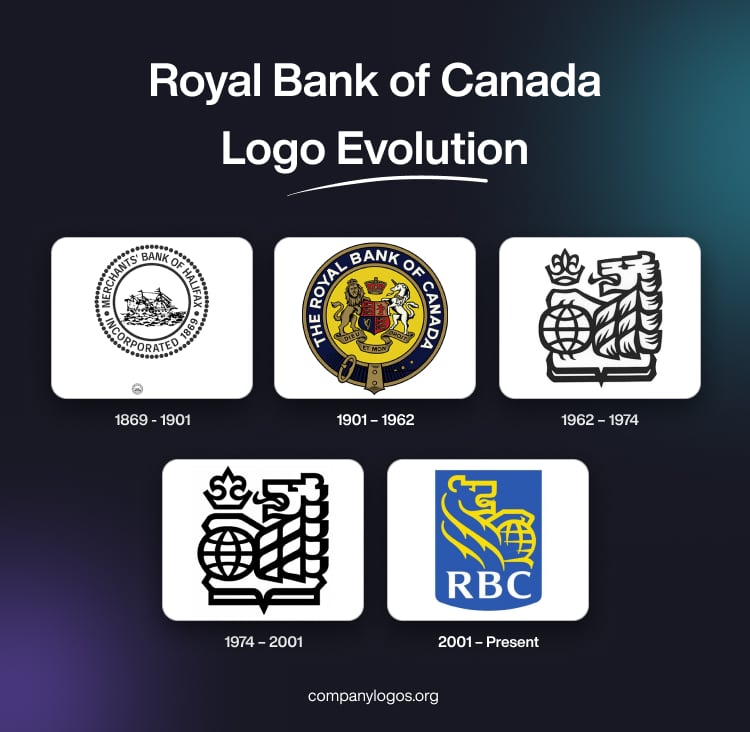
The Royal Bank of Canada, or RBC, is one of the largest and most influential banks in Canada and globally. Established in 1864 in Nova Scotia, by sea merchant entrepreneurs, as the Merchants Bank of Halifax, the Royal Bank of Canada operates worldwide and has a customer base of more than 15 million across the globe.
The logo of RBC is famed for its regal lion and globe, and has been a key branding element that reflects the bank’s values, growth, and global aspirations. The article explores the history of various logo iterations of the bank over the years, among other details.
The Genesis of the Royal Bank of Canada Logo (1864 – 1869) (Unavailable)
The Royal Bank of Canada (RBC) traces its roots back to the Merchants’ Bank of Halifax, founded in 1864. The early banking symbol(s) is not available. In fact, the first known logo for the bank is from the year 1869 and which lasted till 1901.
(1869 – 1901)
The first logo or corporate seal of the Merchants Bank of Halifax featured two concentric circles where the inner circle showed a modern three-mast sailing ship with an auxiliary engine. The circular edge had the inscription “MERCHANT’ BANK OF HALIFAX” and “INCORPORATED 1869” in uppercase monochrome. The outer circle constituted a series of black dots rather than a curved line.
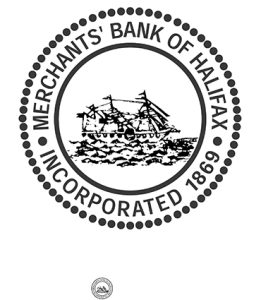
(1901 – 1962)
In 1901, after the renaming of the Merchants Bank of Halifax to “The Royal Bank of Canada,” the bank revised its seal. This new identity focused on the “Royal” name and incorporated elements that were inspired by Britain’s Royal Coat of Arms. The use of a royal insignia was intended to impart values of strength, tradition, and stability. The main elements of the logo were a lion, a Scottish unicorn, a coat of arms, a crown, and a ribbon with the words “AMARI USQUE AD MARE.”
These were placed within a yellow circle in a blue strap ring. The new name “THE ROYAL BANK OF CANADA” was written along the edge of the circle in bold white uppercase. This became Royal Bank’s first widely recognized symbol and showed its growing stature across Canada and abroad.
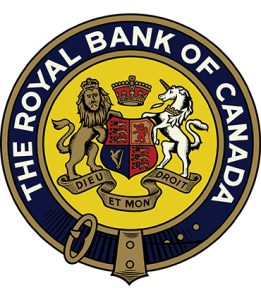
(1962 – 1974)
A major rebranding occurred in 1962, wherein RBC introduced its first modern logo. Designed by the legendary American studio Lippincott & Margulies, the new design embraced heraldic motifs by blending four key elements in grey and white. These include the lion to represent strength and authority, the crown to emphasise the royal aspect, the globe to symbolise RBC’s growing international presence, and the Fleur-de-lis flower to reflect the bank’s Canadian roots. The lion was turned to the left and enlarged to keep the focus on its head and the mane. It held its front paw on the globe to symbolise the growing presence of the bank.
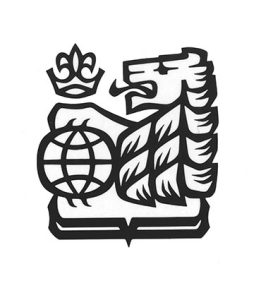
(1974 – 2001)
In 1974, legendary designers Freddi Jaggi and Fritz Gottschalk further refined the logo. Their redesign involved simplifying the image by removing the finer details, such as the lion’s mane in favour of bolder, cleaner lines. Thus, by enhancing scalability and legibility, the logo was made to fit on both signage and printed materials. Besides, the colour grey was replaced with black. This iteration of the “Lion and Globe” established the foundation for what would become one of Canada’s most recognized corporate emblems.

(2001 – Present)
In 2001, the heraldic shield in deep blue colour with a rectangular rounded base made a comeback. Inside the shield appeared the contours of a golden lion facing right with a globe at the top. The bottom of the shield had the inscription “RBC” in white uppercase.
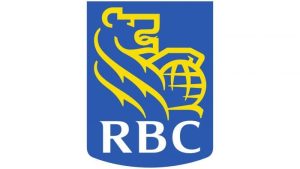
The Elements of the Royal Bank of Canada Logo
Font
The abbreviated wordmark of the Royal Bank of Canada logo is rendered in a bold, custom serif typeface in uppercase. The uneven thickness of the strokes changes from wide to narrow, thereby making the logo unique. The fonts that are similar to this are Aviano Serif Black or Sava Semi Bold.
Colour
The Royal Bank of Canada logo employs a combination of blue, yellow, and white colours to add a touch of professionalism, energy, and confidence.
The History of Royal Bank of Canada
The Royal Bank of Canada, or RBC, is the largest bank in Canada by market capitalization and is one of the largest globally. It boasts a rich history that dates back over 160 years. Founded in 1864 as the Merchants Bank of Halifax by a group of maritime merchants in Nova Scotia, the bank was originally created to support the growing trade of the region, especially in fishing, timber, and international commerce with Europe and the Caribbean. In 1869, the Merchants Bank of Halifax received its federal charter and became a public company with an initial capital of $300,000.
As the bank expanded across the Maritimes and other regions, it opened its first international branches in Bermuda and Newfoundland in 1882 and, by 1897, established a presence in Western Canada through a Vancouver branch. It also entered key financial centres like Montreal and New York City by the turn of the century. In 1901, it officially changed its name to the Royal Bank of Canada and moved its head office to Montreal.
The early twentieth century was a time of rapid growth, and it involved strategic mergers with the Union Bank of Halifax (1910), the Quebec Bank (1919), and the Union Bank of Canada (1925). These mergers propelled RBC to the status of Canada’s largest bank by assets. Its international reach extended further during this period, and included the opening of a U.S. branch in 1910 and expansion throughout the Caribbean.
Innovation has long been a hallmark of RBC’s corporate culture. The bank was the first in Canada to introduce computer technology in the form of an IBM system in 1961 to streamline its operations. Other innovations included the introduction of Canada’s first drive-in teller service in 1935. In 1976, in alignment with the broader shifts in the country’s financial sector, RBC moved its headquarters from Montreal to Toronto. The ensuing decades saw RBC diversify geographically and operationally. It made key acquisitions both domestically and internationally, especially in the U.S. and Caribbean.
In the 21st century, RBC continued to assert its dominance through acquisitions such as Liberty Life (2001), City National Bank (2015), and Brewin Dolphin (2022). A milestone came in 2024 when RBC completed its acquisition of HSBC Bank Canada to further cement its leading position in the market. By the end of the 2024 fiscal year, RBC reported record earnings of $16.2 billion and a Return on Equity of 14.4%.
RBC operates in over 50 countries and offers a comprehensive suite of financial services to millions of customers worldwide. Its legacy is marked by visionary leadership, strategic mergers, technological innovation, and an unwavering focus on international trade. Throughout its history, RBC has consistently adapted to economic challenges, world events, and the evolving digital landscape.
Additionally, it is recognized for its social initiatives, that is, from publishing the influential “RBC Letter” to supporting employees and communities during major world events. In fact, the transformation of RBC as a global financial powerhouse reflects Canada’s own transformation into a leading modern economy.
Interesting Facts About Royal Bank of Canada
- RBC was originally founded in 1864 as the Merchants Bank of Halifax in Nova Scotia, and not Toronto or Montreal as many assume. It became the Royal Bank of Canada in 1901 after receiving a federal charter.
- RBC is consistently ranked as Canada’s largest bank by market capitalization, assets, and net income. It serves over 17 million clients worldwide.
- Despite its Canadian roots, RBC operates in over 30 countries, including the U.S., the Caribbean, Europe, and Asia. It has a strong international banking presence and is one of the few Canadian banks with a significant U.S. footprint through RBC Bank and City National Bank.
- RBC has been at the forefront of banking innovation. For instance, it is one of the first Canadian banks to offer mobile banking apps, launched NOMI, an AI-driven personal finance assistant, and invests heavily in fintech and blockchain research through RBC Ventures.
- RBC is a leader in sustainable finance. It is committed to providing $500 billion in sustainable financing by 2025. Also, it regularly appears in sustainability indexes such as Dow Jones Sustainability Index and Bloomberg Gender-Equality Index.
- RBC is one of the largest private employers in Canada, with over 90,000 employees worldwide. It is known for promoting diversity, equity, and inclusion in the workplace.
- RBC has operated in the Caribbean for over 100 years. It is one of the most widespread foreign banks in the region, with a presence in countries like the Bahamas, Trinidad & Tobago, Barbados, and more.
- In 2015, RBC acquired City National Bank, which is a Los Angeles-based bank known for serving Hollywood and high-net-worth clients. It’s now called “The Bank to the Stars.”
- RBC frequently appears in Forbes and Brand Finance lists of the world’s most valuable banking brands. Its global reputation is supported by strong customer service, innovation, and financial stability.
- RBC is a major sponsor in the world of sports. These include being the title sponsor of the RBC Canadian Open (PGA golf) and being the sponsor of Team Canada Hockey, tennis events, and the Olympics.
- The RBC Foundation donates millions annually to causes like education, youth empowerment, mental health, and Indigenous communities. Its “Future Launch” initiative helps young people gain skills for the modern workforce.
- The bank received its “Royal” designation from Queen Victoria, which is a rare honour for a financial institution. It reflects the bank’s early connection to the British monarchy.
- RBC’s investment banking division, RBC Capital Markets,is among the top global investment banks. It offers services in mergers and acquisitions, trading, and wealth management.
- RBC has shown remarkable resilience during financial downturns, such as the Great Depression, the 2008 Financial Crisis, and the COVID-19 pandemic.
Finally
The evolution of the Royal Bank of Canada logo is a powerful narrative of how a visual identity can reflect institutional growth, heritage, and forward-looking vision. From its early, unofficial emblems to the globally recognized lion-and-globe insignia, RBC’s logo tells a story of prestige, progress, and purposeful design.